Based on a presentation by Dr. Altus Viljoen during the TFNet Workshop on ‘Enhancing Market Access for Tropical Fruits in East Africa and GCC Countries through Quality Improvement, Proper Post Harvest Handling and Pest and Disease Management’ in Khartoum, Sudan on 4-5 March 2015.
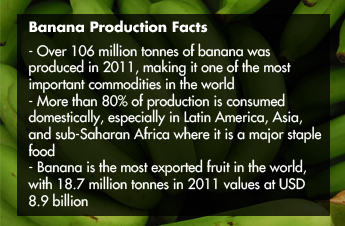 Half a century ago, the global banana industry was on the verge of collapse. Plantations in the tropical Americas were struck with Banana Fusarium Wilt, a fungal disease, virtually wiping out the dominant banana cultivar, Gros Michel. Reliance on the vulnerable Gros Michel and using infected rhizomes to establish new plantations resulted in severe widespread losses.
Half a century ago, the global banana industry was on the verge of collapse. Plantations in the tropical Americas were struck with Banana Fusarium Wilt, a fungal disease, virtually wiping out the dominant banana cultivar, Gros Michel. Reliance on the vulnerable Gros Michel and using infected rhizomes to establish new plantations resulted in severe widespread losses.
To sustain commercial banana production, the industry switched to Cavendish cultivars, which were resistant to the Fusarium Wilt disease caused by Fusarium oxysporum cubense (Foc) Tropical Race 1. Since then, it has been the preferred cultivar for import and export worldwide.
Causal agent
Fusarium Wilt is a vascular wilt disease caused by soil-borne fungi Fusarium oxysporum f. sp. cubense (Foc) that affects bananas and other crops.
The initial symptoms of Fusarium Wilt are yellowing of the roots and rhizomes, which progresses to the pseudostems and the leaves. The leaves turn yellow – starting from the older to younger leaves – and eventually leads to bending of the petiole that can be described as a “skirt of death” around the trunk. Infected plants have little to no chance of recovery.
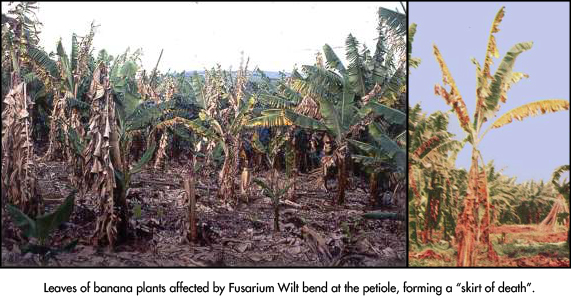
While the plant is dying, the fungus multiplies and develops spores that can remain on the soil for decades. If susceptible plants are grown nearby, the spores germinate, infect the plants, and kill them. Hence, contaminated soils become unfit for production unless resistant varieties are grown.
Fusarium wilt epidemics are largely due to plantation style monoculture production systems, , expansion of international trade especially of the Cavendish cultivar, poor enforcement of quarantine regulations and unchecked movement of infected planting materials and equipment.
Without a global replacement for Cavendish bananas readily available, Fusarium Wilt poses a significant threat to banana production worldwide.
Causal agent
Fusarium Wilt is a vascular wilt disease caused by soil-borne fungi Fusarium oxysporum f. sp. cubense (Foc) that affects bananas and other crops.
The initial symptoms of Fusarium Wilt are yellowing of the roots and rhizomes, which progresses to the pseudostems and the leaves. The leaves turn yellow – starting from the older to younger leaves – and eventually leads to bending of the petiole that can be described as a “skirt of death” around the trunk. Infected plants have little to no chance of recovery.
While the plant is dying, the fungus multiplies and develops spores that can remain on the soil for decades. If susceptible plants are grown nearby, the spores germinate, infect the plants, and kill them. Hence, contaminated soils become unfit for production unless resistant varieties are grown.
Fusarium wilt epidemics are largely due to plantation style monoculture production systems, , expansion of international trade especially of the Cavendish cultivar, poor enforcement of quarantine regulations and unchecked movement of infected planting materials and equipment.
Without a global replacement for Cavendish bananas readily available, Fusarium Wilt poses a significant threat to banana production worldwide.
Is history repeating itself?
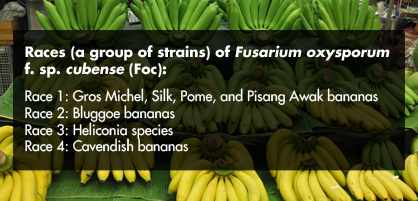 While Cavendish continued to perform well for a few decades, it has become vulnerable to new strains of Foc called Tropical Race 4 (TR4). Other banana cultivars and plantains have also shown susceptibility to Foc TR4. The Food and Agriculture Organization of the United Nations (FAO) even estimates that 80% of total banana and plantain production are based on vulnerable germplasm.
While Cavendish continued to perform well for a few decades, it has become vulnerable to new strains of Foc called Tropical Race 4 (TR4). Other banana cultivars and plantains have also shown susceptibility to Foc TR4. The Food and Agriculture Organization of the United Nations (FAO) even estimates that 80% of total banana and plantain production are based on vulnerable germplasm.
The destructive impact of Foc TR4 on Cavendish plantations was first observed in Taiwan in the 1960s, reducing production to only 10% of former levels. In 1990s, Foc TR4 destroyed thousands of hectares of Cavendish in Indonesia and Malaysia worth millions of dollars in losses.
TR4 has also been found in the Philippines, the 2nd largest banana exporting country in the world, threatening the 400-million-dollar industry. It has also spread to China, which is the 3rd largest banana producer in the globe.
Evidently, the recent outbreaks in Oman, Jordan, Pakistan, Lebanon, Australia, and Mozambique attest that Foc TR4 is an international threat to the multimillion export business. In addition to this, millions of people in the rural communities who depend on bananas for their food security and livelihood are also at risk.
Fusarium Wilt in Africa
Bananas and plantains are critically vital to food security and income generation of more than 70 million Africans. People from the highlands of central Africa eat more bananas than anyone else in the world, accounting to 35% of their daily calorie intake. Although highland bananas have shown resistance to Fusarium Wilt Foc TR4, Cavendish plantations have been increasing in western, eastern and southern Africa with investments from Europe and China.
In February 2013, TR4 was detected in a Cavendish plantation in Mozambique. Fortunately, the affected farm is isolated from other banana production areas. The company is also financially capable and recognizes the responsibility to introduce sanitation measures to prevent spread and contain the disease.
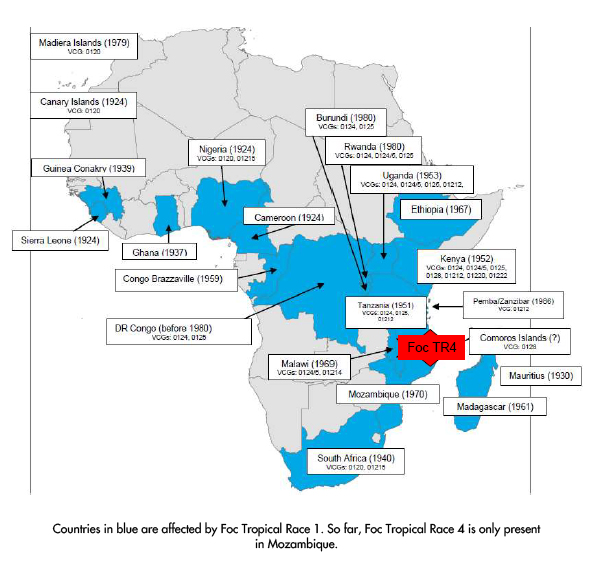
However, plenty of work should still be done in the region to prevent the disease from being re-introduced and spread.
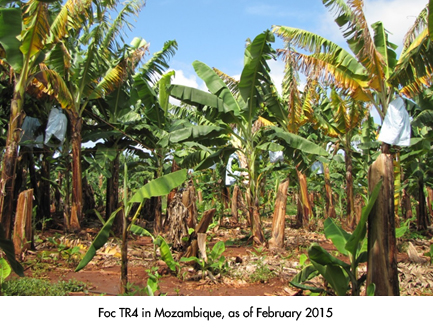
Addressing the threat in Africa
In April 2014, members of the African Consortium for Foc TR4 (AC4TR4) conducted a workshop to develop an action plan for Foc TR4 in Africa. AC4TR4 consists of experts from Stellenbosch University, Food and Agriculture Organization of the United Nations (FAO), the Consultative Group for International Agricultural Research (CGIAR), Common Market for Eastern and Southern Africa (COMESA), The East African Community (EAC), Southern African Development Community, International Institute of Tropical Agriculture (IITA), Bioversity International, and the Association for Strengthening Agricultural Research in Eastern and Central Africa (ASARECA).
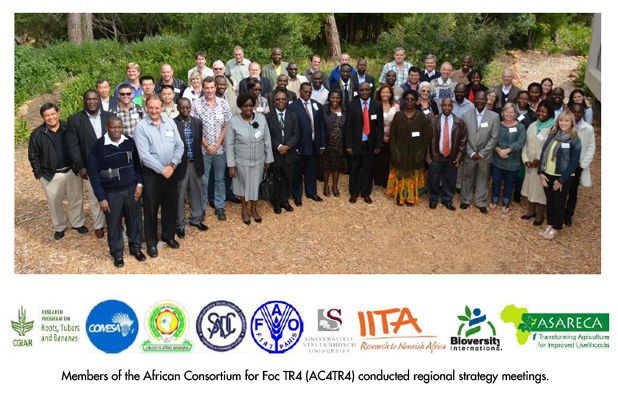
The goal of the action plan is to control the current disease outbreak of banana Fusarium wilt in Mozambique and to prepare other African countries that rely on banana for food security and income generation, against similar incursions.
The action plan also provides details to strengthen the capacity of the National Agricultural Research System (NARS) to sustainably manage the disease, institute mechanisms to coordinate and communicate AC4TR4 activities in Africa, and carry out research to generate new information and technologies for the sustainable management of Fusarium Wilt.
Together with Bioversity International, AC4TR4 sent East African Highland Bananas (EAHB) and plantains to the Philippines to evaluate their susceptibility to Fusarium Wilt. Other than the Ibwi and Williams varieties, most varieties of EAHB show resistance to Foc TR4.
AC4TR4 has also provided assistance in managing Fusarium Wilt in Mozambique, provided resistant somaclones, conducted awareness campaigns, and organized trainings for different stakeholders.
Global Efforts
Cognizant of the threat of this deadly disease, the Food and Agriculture Organisation of the UN (FAO) have initiated a technical consultation group to create a Global Programme on Prevention of Fusarium Wilt (Foc) Disease on Banana. The programme aims to conduct activities on six major thematic areas: awareness, surveillance, risk assessments, preparedness, disease management strategies, and international coordination.
With global food security and livelihood at stake, protecting bananas against Fusarium Wilt is the responsibility of multiple of stakeholders such as international, regional, and national authorities, research scientists, extension officers, and producers. This can be achieved by means of enhanced awareness, legislation, regulation, and quarantine. With proper knowledge of the disease, we will be able to save the banana.
International Tropical Fruits Network (TFNet) is also involved in the various efforts to manage and contain the disease as well as prevention of spread, through capacity building programs and awareness campaigns.
